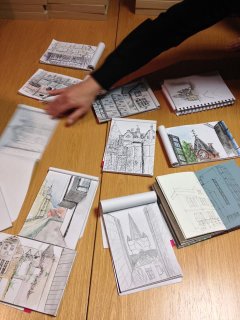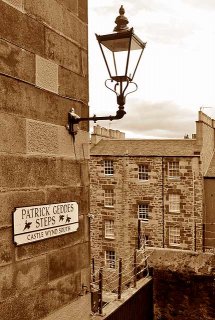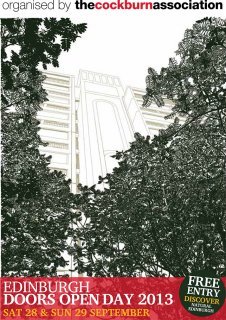Yasmin Ali
Urbanism // Design
Britain from Above does The Big Draw @ RCAHMS, 10-4pm, 18.10.2013
October 18th, 2013This year RCAHMS' Education and Outreach department teamed up with illustrator and designer Mark Kirkham, who runs the blog Edinburgh Sketcher, to host a drawing and information day as part of The Big Draw Campaign, which runs annually at venues throughout the UK, and internationally.
The day was in two parts, with the morning session focussing on an introduction to the Britain from Above project, a historical aerial photography archive by Aerofilms Ltd., of which over 95,000 digitally remastered images taken between 1919-1953, have been scanned and digitised online at the online resource of the same name. The project is run in partnership with English Heritage and RCAHMW, RCAHMS' counterparts in England and Wales.
Aerofilms Ltd. was remarkable as the UK's first commercial aerial photography company, and held specialist stereoscopic equipment at that time not used elsewhere in the UK. As such, their resources and skills were called upon by the military in wartime Britain. In total, their work spans over 1.26 million negatives and 112 million photographs taken over a 75 year period, covering almost every community in the UK at various stages. This provides a resource for understanding the morphology of built and natural environments.
RCAHMS is the acronym for The Royal Commission on the Ancient and Historical Monuments of Scotland, which has a wealth of resources available to members of the public and professionals alike. The Library and Print Room were introduced in the second half of the morning, with a look at original and reproduced samples of maps, drawings and etchings, posters and books available for reference and photocopying.
In the afternoon, Edinburgh Sketcher Mark was invited to host a three hour sketching tour around the Southside, University campus and Old Town, and led a group of around a dozen adults around some of the Southside's hidden corners, noting details, possible techniques and focusing on the juxtaposition between old and new.
Participants were generously equipped with fine ink pens, pencils, sketch pads and watercolour sets and encouraged to sketch under time pressure and not to be afraid to commit pen to paper. The day concluded with an informal group review of the results and framing of a finished piece for each sketcher apprentice to take home.
Weblinks
Britain from The Air - here
The Big Draw - here
Edinburgh Sketcher - here
RCAHMS - here
The Big Draw runs until 3rd November at various venues.
RCAHMS is open to the public from 930-1700 Tues-Fri, and is sited at John Sinclair House, 16 Bernard Terrace, Edinburgh EH8 9NX.
Film Review: The Human Scale @ CCA, 730-10pm, 11.10.2013
October 12th, 2013In advance of its America premieres this weekend, Take One Action Film festival brought two Scottish screenings of acclaimed documentary 'The Human Scale', to Edinburgh and Glasgow respectively. Preceeding each screening was a guided walk arranged by A+DS around the two cities, and an audience discussion led by David Sim of Gehl Architects and Planning Aid Scotland to discuss some of the issues raised followed the film showings.
The Human Scale begins with portraits of people who appear as global citizens but emerge through the film's narrative to be urban planning officials within their respective cities, each with a perspective on how their respective cities should be designed for growth with people in mind. A piece of documentary film making, the key characters are the cities themselves which are arranged into themed chapters, each of which deals with a specific question relating to key philosophies regards people-centred urban design. Renowned architect and urbanist Jan Gehl and his colleagues feature as key speakers regards their experiences studying, enlivening and replanning cities as diverse as Copenhagen, Siena, Chongqing, New York and Christchurch.
The Human Scale as working terminology pretty much sums up Gehl's approach regards creating places for people to use, enjoy and socialise. As an architect and urban designer with over forty years' experience, he is renowned for his humanistic approach which goes against what was avant-garde at the start of his career, which saw the work of modernist architects and early town planning experiments which were car-centric, encouraged sprawl, monoculture and high-density mass housing.
As well as hearing from Gehl, we meet a few of his colleagues including Scots architect David Sim who gives an engaging account of some of his work masterplanning Christchurch in the wake of its recent devastating earthquake in 2011. Sim led a people-focused public consultation on ideas for the replanning of Christchurch, where citizens were encouraged to give their views openly without being prejudiced to any proposals. The general ideas matched in terms of broad themes Gehl architects' key findings for people-centred design, like the provision of open spaces, cycle lanes, public squares, low-rise, low-density living, and places for play and social activities. Interestingly, capping the storey heights at around 6-7 storeys also has a return for more efficient yields in terms of real estate given the lack of need for reinforced structural support which is necessary for higher buildings. This was a key factor which the public lobbied for after the masterplan visioning was taken over by central government task force part way through its implementation, again highlighting the importance of engaging citizens as state actors within the planning process.
The film has yet to be screened in America and Denmark, but has already featured globally in several film festivals, and attracted nominations and awards such as The Aljazeera International Film Festival Long Film Award, and The Official Selection at the Sydney Film Festival.
running time: 77mins // English / Danish // production: Final Cut for Real
Screening courtesy of Take One Action Film Festival / CCA Glasgow
Walks in conjuction with A+DS
Film website - here
Take One Action website - here
A+DS Corporate Strategy Consultation Workshops
October 10th, 2013On the 9th October I attended the last in a series of Scotland-wide workshops designed to canvas opinion for they way ahead for A+DS' Corporate Strategy for the next three years. The Edinburgh workshop, hosted at their HQ in Bakehouse Close, was well-attended by professionals from architecture and a range of allied disciplines, including landscape architecture, town planning and public art.
Attendees were invited to discuss in small groups the consequence of four key questions related to the remit of A+DS; namely:
- What does A+DS do?
- What do you value most about the work of A+DS?
- What do you value least about the work of A+DS?
- What do you think A+DS should add to their work?
The questions prompted lively discussion and debate, including the consequence of A+DS current non-statutory status; its role in procurement; and marketing activities. At the end of the workshop, participants were encouraged to highlight up to ten of the points as key priorities. It emerged that promotion of the added value of design and a role in place-making, including the championing of the design of the mundane were identified as key roles of A+DS on which to focus for the coming three years.
A+DS provides advice and resources for professionals in architecture and its allied professionals, and education programmes for all ages. It has a wide remit covering six themed programmes:
- Access - related to education;
- Smarter Places - schools design;
- Healthier Places - healthcare design;
- Sust - sustainable design;
- Urbanism - urban design;
- Design Forum - design panel reviews
It also now is covered by the recent Scottish Government's Policy Statement, Creating Places, 2013:
“Architecture and Design Scotland is a champion for good architecture, design, placemaking and planning. It works to help deliver Scottish Ministers’ policies and objectives for the built and natural environment for the benefit of the people of Scotland”.
Workshops were held at major cities throughout Scotland, with attendees from each RIAS Chapter of Architects.
If you missed these, or would like to have a more detailed say, you can take part in the online survey for consultation, available until the end of this month, at this link.
Patrick Geddes: A Modern Thinker, Talk by Prof. Aubrey Manning@Scottish Historic Buildings Trust, 6-730pm Friday 27.09.13
September 29th, 2013This year's series of talks for Edinburgh's edition of Doors Open Day has welcomed experts from a range of disciplines to speak on architecture and related topics. Aubrey Manning is a distinguished professor of Zoology, and spoke on the legacy of polymath and pioneer Patrick Geddes, a 'prophet without honour', being understated in modern history so far, despite significant contributions to fields as diverse as ecology, sociology and town planning.
Geddes' strength lay in his prescience regards anticipating social needs, and his ability to think laterally and synthesise information from myriad fields to give a holistic approach to analysis. Manning relates the remarkable story of a young biologist praised by contemporaries and seniors as renowned as Darwin and Huxley, but denied a chair at Edinburgh University due to his lack of a completed undergraduate degree. Geddes assumed Chair of Botany at Dundee University, then led a varied career which opened up opportunities to present ideas in London, and travel and work on town planning projects in India.
Despite lack of recognition from the city's establishment, Geddes achieved social change in Edinburgh with his approach of 'Conservative surgery' to counter the effects of the grid-iron plan. In the Grassmarket, home of the Scottish Historic Buildings Trust (SHBT) in Riddle's Court, Geddes rescued the slums of the early 20th century from further decay and prospective demolition by selectively removing sections to decrease density, increase access to modernised services and sanitation and create inner courts and gardens. This approach allowed the best properties to be retained and restored, and their amenity value increased by the new open courts.
Geddes also bought and brought and innovative outward-looking exhibition to the Camera Obscura further along the Royal Mile. Manning describes how Geddes is beginning to be memorialised around the area, with a recent cast bust in the garden of Sandeman House off High St, and a plaque at Patrick Geddes Steps, leading from Johnston Terrace to the Grassmarket. Uniquely, the street name in the Old Town lettering also contains Geddes' three doves symbolising Sympathy, Synergy and Synthesis, three tenants of Geddesian thinking.
Manning presented an interesting and informative narrative detailing aspects of Geddes' life and work and highlighting ideas of note worth remembering.
The SHBT is currently raising money to complete funding for the proposed Patrick Geddes Centre for Learning and Conservation. The fund can be seen here.
Doors Open Day Edinburgh, Talk: 'Footfall' by Malcolm Fraser@RCAHMS, 1-2pm Monday 23.09.13
September 23rd, 2013Edinburgh architect Malcolm Fraser presented a talk at two scales: firstly, his work with the National Review of Town Centres in Scotland, which seeks to recommend general strategies for to improve the vibrancy and viability of Scottish Town Centres as places of economic growth and interest. Secondly, he presented a series of projects from his own practice which mediate sensible use of space and siting and reflect aspects of the thinking behind the report's principles in general, where appropriate.
The title 'Footfall' neatly summarises both the commercial aspirations of inner-city developers (particular retailers), and the human-scale consideration of Fraser's work. Stand-out projects included a mixed-use development in Stromness which mimicks the traditional urban form of enclosed courtyards to mask the effect of the wind, and a scheme for Lews Castle & Museum, currently on site, which breaks boundaries with its innovative use of displays and the landscape.
Fraser also provides a whistle-stop tour in slides of some of his best known arts buildings throughout Edinburgh, including the National Poetry Library, National Storytelling Centre and Dovecot Studios, all of which worked against some unworkable existing arts strategies. A new building to check out this Doors' Weekend is surely his recently completed Edinburgh Centre for Carbon Innovation (ECCI), which fittingly, is the first ever development of its kind to achieve an “outstanding” rating from BREEAM, the world’s leading sustainability rating system for the built environment.
The talk was the first in a series of lunchtime talks held at The Royal Commission on the Ancient and Historical Monuments of Scotland (RCAHMS) for this year's Doors Open Day, which in Edinburgh's case has extended to a week of lively talks, walks and the obligatory weekend of exclusive building visits.







